Easter had come and gone, and there was a promise of sunshine, so we planned a trip to Wales, heading for Pembrokeshire and St Davids, in the south-west.
We chose to stay at Caerfai Bay Caravan and Tent Park, just outside St Davids. On arriving, we took a quick walk around the campsite, discovering a beautiful clifftop location with stunning views of the coastline, a view which saw Caerfai Bay included in our guide to the best campsites in Wales with sea views.
Next morning, we awoke refreshed after enjoying a peaceful night and were keen to get out and about and explore St Davids. The best motorhome sites will provide plenty to do in the surrounding area, and here, it was an easy one-mile walk along a quiet country lane to reach this fine cathedral city.
Our stroll into St Davids took us past the Oriel y Parc Gallery & Visitor Centre. This is advertised as a destination in itself, so we decided to stop and have a quick look around. In 2007, this thriving cultural centre was built using green technologies. It boasts several eco-friendly features, including grass and sedum roof spaces.
Exploring St Davids
St Davids is Britain’s smallest city, but you shouldn’t expect a bustling metropolis – this charming little place is actually much more like a medium-sized village. It’s very pleasant.
Historically, towns with a cathedral were automatically given city status, so St Davids became a city in the 12th century. However, the rules changed in the 19th century and it lost its city ranking. Then in 1995, that title was restored by Royal Charter. There are several pretty streets, scattered with independent shops and cafés, which are pleasant to wander around.
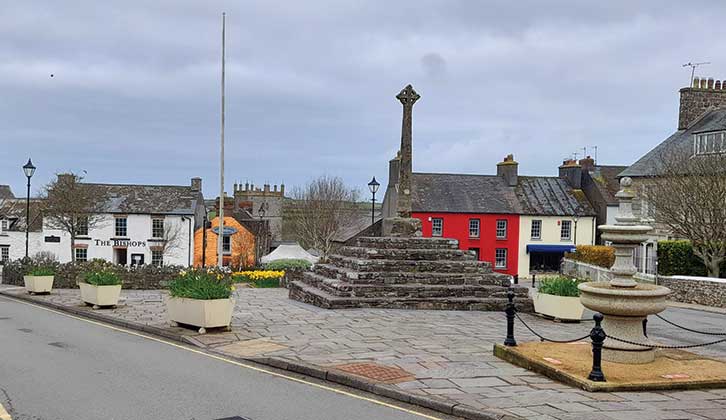
Many of the older houses were built in flint, the traditional construction material of the area, and there is a market cross in a small square beside a war memorial garden. Both seemed to be excellent places for visitors and walkers to stop off for a breather.
We were heading towards the cathedral, so we followed the signs down the hill and along a street leading to an ancient gatehouse. We had read about the cathedral before visiting, but were not prepared for the impact of our first view as we passed through the stone gatehouse.
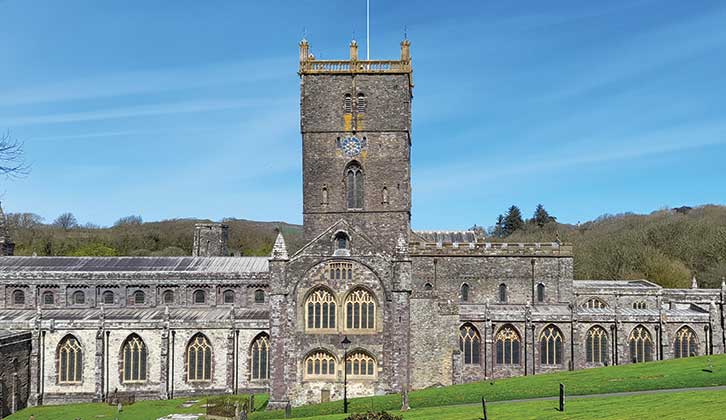
This, the only remaining gatehouse of the four that were once part of the 15ft-high defensive wall ringing the city in medieval times, rather hides the cathedral from view as you approach.
Many cathedrals are imposing edifices that dominate their surroundings, but St Davids lies in a valley, hidden from sight until you emerge through the gate – then the full magnificence of this great cathedral is laid out before you.
An ancient cathedral
Like many historic cathedrals, St Davids was originally founded as a monastery. Over the centuries, parts of the building were destroyed and rebuilt, so today’s cathedral is a composite of different ages, with the oldest sections dating back to the 13th century.
During the 17th-century Civil War, soldiers of the Commonwealth destroyed the cathedral’s stained-glass windows and removed the bells from the tower. Fortunately, the building that we can see today was extensively restored during the 18th and 19th centuries.
The first thing we noticed when we entered was that some of the huge pillars seemed to be leaning significantly, which was a bit alarming!
Apparently, there were wet foundations when it was being built, which means the west and east ends of the structure now differ in height – by as much as four metres.
Looking around, we felt this cathedral was not as ornately decorated as some others that we have visited, although there is an intricately carved timber ceiling to admire, which dates all the way back to the 15th century.
St Davids houses the splendid tomb of Edmund Tudor, father of Henry VII. His stately memorial was funded by his grandson, Henry VIII. It is to be found near the ancient Shrine of St David, founder of the cathedral.
After pausing for a while to enjoy a snack and a drink in the café, we explored the delightful grounds outside, discovering that the River Alun runs past the cathedral. Footbridges lead you across to the Bishop’s Palace.
The Bishop’s Palace
St Davids was an important centre of pilgrimage in medieval times. In the 14th century, Bishop Henry de Gower built a magnificent palace here, befitting what he felt was his status.
In those days, bishops were not just high-status priests in the Church – they were also known for their buildings. The palace Henry built replaced the old monastery which had stood on the site. However, by the 16th century, the building was in a state of disrepair and keeping such a large house was a great drain on the resources of the diocese, so the Bishop’s residence was moved to Abergwili, near Carmarthen.
Around this time, one Bishop Barlow is reputed to have stolen the lead from the palace roof, to pay for his daughter’s wedding – although some historians maintain that this was a scurrilous story fabricated by his enemies!
Visiting Pembroke
No holiday in Pembrokeshire would be complete without visiting Pembroke, a small town near the south-west coast.
The castle dominates the skyline, and we felt drawn to visit there first (the Commons car park – postcode SA71 4EA – has space for motorhomes). Originally built in 1093 by Earl Roger de Montgomery after the Norman invasion, it had an excellent defensive position. It was set on a promontory overlooking Milford Haven and withstood many attacks.
After the Civil War in 1648, disgruntled soldiers of the Parliamentarian army, who had apparently not been paid, occupied the castle for some eight weeks. Oliver Cromwell himself took charge of the final assault against them.
After the siege was over, Cromwell was held responsible for much of the damage to the castle, which he ordered destroyed, so it could never be used defensively again.
The historic castle is now privately owned and administered by a charitable trust, and the admission price includes a guided tour.
The castle’s Great Keep is a rather imposing 80ft-high tower and would have been the main stronghold. It was closed when we visited, but that was probably a blessing, because there were plenty of other stone staircases to climb as we explored the other towers and the outer walls of the castle. There is a lot to see here – and a very pleasant café, too.
Pembroke is a well-preserved medieval walled town. The one remaining tower in those walls, Barnard’s Tower, was built in the 13th century, on the north-east corner. There is an excellent Town Trail available online, which points out areas of interest and guides you on a pleasant walk.
Beautiful beaches
The next morning, we headed for Tenby. Having never visited this famous resort before, we were impressed with the beautiful beaches. Tenby is blessed with four – North, South, Harbour and Castle Beaches – providing visitors with 2.5 miles of glorious coastline to explore (for a list of suitable car parks, see www.pembrokeshire.gov.uk/parking-in-pembrokeshire/motor-homes).
The harbour is small and close to the oldest part of the town, with the imposing ruins of the Norman castle on a hill above.
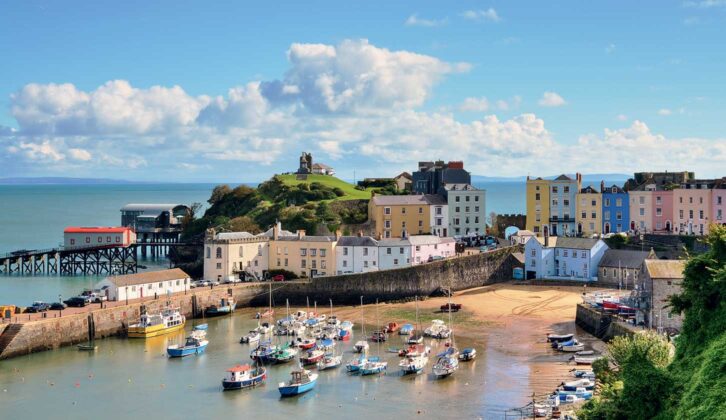
All that remains of the castle these days is the small keep tower, dating from the 13th century, although the original construction is thought to date all the way back to the 11th century.
Tenby also has well-preserved medieval town walls. There were originally four gatehouses in the walls – the western gate still exists, and is now known as the Five Arches Gate.
Strolling in the centre of town, we discovered a wonderful National Trust property, the Tudor Merchant’s House. This three-storey lime and sandstone house tells the story of when Tenby was a thriving port. Each room has been set as if the merchant still lived there.
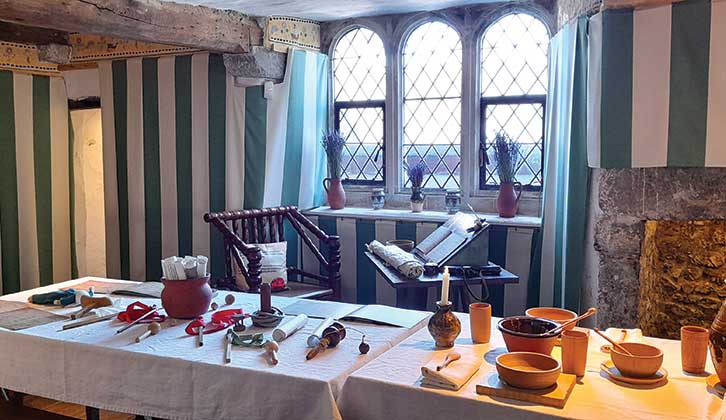
Next day, we decided on a day out by bus and walked to St Davids to catch the T11 to Fishguard. The bus dropped us conveniently in the town centre. We walked through the town and found a footpath leading down a hillside through some delightful woodland.
That seemed a better bet than continuing on the road, so we opted to follow the steep path. We eventually emerged on a quayside and took the path through a boatyard. The tide was out, but that did not detract from the beauty of the quay, overlooking Fishguard Bay and the Gwaun Valley.
We had discovered Lower Fishguard. Once the centre of the busy local herring industry, the quay is lined with charming traditional cottages.
The Fishguard Bay Yacht Club has a small café on the quayside, where we enjoyed a good lunch. The views were excellent – we could see across to the other side of the bay, where we had walked down from the hill and Upper Fishguard.
After a leisurely lunch, we headed back over the road bridge, then explored another path up the steep headland towards the upper town. Halfway along, we found a trail going around the headland, which provided splendid views over Lower Fishguard.
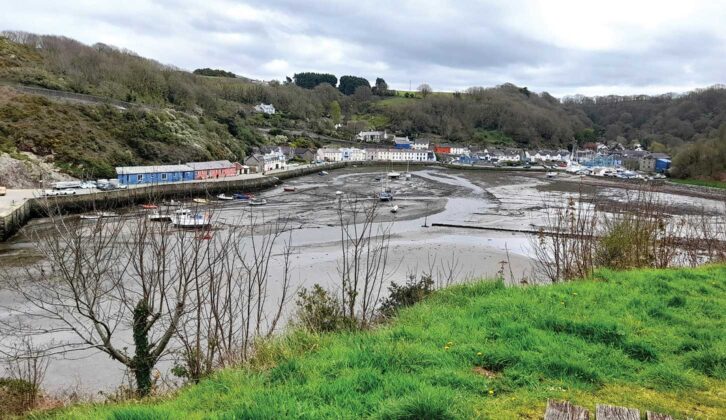
From our vantage point, we could just see the remains of Fishguard Fort, perched on the opposite headland looking out to sea.
This 18th-century structure is famous for its part in the 1797 Battle of Fishguard, known as the last invasion of the British mainland, when soldiers of Revolutionary France waged a brief military campaign there.
We continued along the path, discovering that we were now on the trail named the Marine Walk, leading down to Goodwick. The ferry terminal is on one side of the bay, but there are some scenic walking trails along the quay.
The Ocean Lab Aquarium is one of the major attractions on the quayside, but after a long day, we decided that it was time to head back to the campsite for a quiet evening.
Pembrokeshire Coast Path
The Pembrokeshire Coast Path runs for 186 miles and is part of the Wales Coast Path. It starts at St Dogmaels in the north and ends at Amroth in the south.
As the path runs alongside the campsite, we decided to take a short walk and set off to explore. Heading west from Caerfai, it is only a brief stroll to St Non’s Chapel. This is thought to be where St David was born and remains an important place of pilgrimage. The modern chapel was built in 1946, while the ruins are in a nearby field.
We continued further along the coast path before reaching the little harbour of Porth Clais, which proved to be the perfect place to pause and admire the splendid sea views.
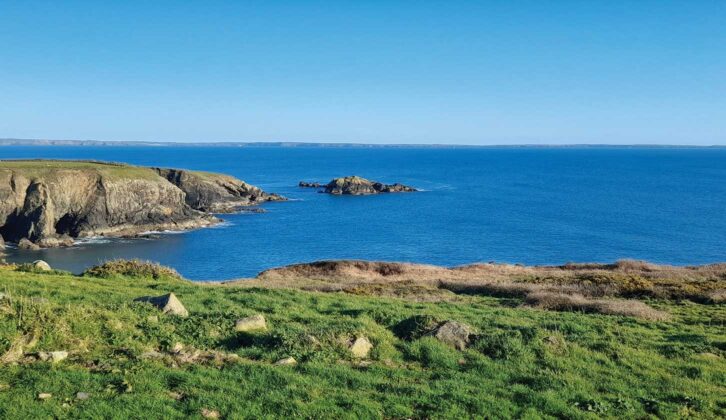
Although we only walked a couple of miles of the path, we would recommend it. The views are spectacular. But it’s unsuitable for anyone with restricted mobility, as it is a bit up and down, with steep steps and rough ground in places.
Walking the other way from Caerfai Bay, it is 4.5 miles to the pretty village of Solva. If you don’t want to walk both ways, the T11 bus goes from St Davids to Solva.
All too soon, our break was over. This part of Wales has much to offer visitors. We found many places that we plan to go back to, and discover some of the things we missed.
Planning your own trip to Wales? Then take a look at our guide to the best motorhome sites in Wales to help you find the campsite to stay at.
Planning a tour to Pembrokeshire
Where we stayed
Caerfai Bay Caravan and Tent Park
St Davids, Haverfordwest SA62 6QT, caerfaibay.co.uk, 01437 720 274
- Open: All year
- Pitches: 60, on a mix of grass and hardstanding. All with electric hook-up and water
- Price: From £32 fully serviced
The site is spread over three fields, tiered so all pitches have a sea view. It’s a one-mile (uphill) walk into St Davids. Buses are available from St Davids to Fishguard or Haverfordwest, but the services are not particularly frequent, so it’s always best to check the timetables.
Find out more
Price: Free to enter, but donations welcomed
Price: Adult tickets £5
Price: Adult tickets £8.50
Price: Adults tickets £6.50
If you’ve enjoyed reading this article, why not get the latest news, reviews and features delivered direct to your door or inbox every month. Take advantage of our brilliant Practical Motorhome magazine SUBSCRIBERS’ OFFER and SIGN UP TO OUR NEWSLETTER for regular weekly updates on all things motorhome related.
When To Visit
Spring or autumn are probably the best times – in summer, it can get very busy and the roads might be a bit tricky with a motorhome.
